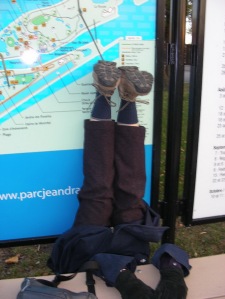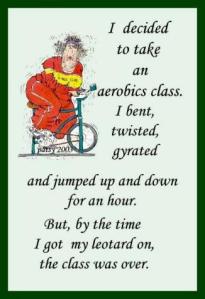Gentle Reader,
My morning routine of lying on the floor, legs over the Back2Life machine, followed by several gentle yoga poses gets my body functioning. I am then ready for the chair chi gong exercises, free weight lifting both standing and the lying on an ethafoam bolster and more stretches with a theraband, emphasizing the IT band with the leg slightly drawn high across the body.
Yoga, what I call the essence of Yoga, is at the core of all this early morning routine. Mary Sue Corrado, my Pilates instructor, worried that I would overdue yoga and increase the damage to the L5 disc, that I would exacerbate the osteoarthritis slowly worsening at age 68. I was training to climb Mt. Shasta, the 14000 ft peak in northern California. I was part of a team climbing to raise money for The Breast Cancer fund, whose aim is to prevent breast cancer by advocating for the elimination of human causes of environmental pollution. All the training materials recommended yoga for core strength.
If you would like to climb mt. Shasta with the best support you could imagine, get in touch with Connie George at the Breast Cancer Fund today and GO FOR IT! It was a top experience of mine and could be yours.
I asked for a private appointment with an instructor at the 8 Limbs yoga studio, only a 1 mile walk from my house in West Seattle. I needed a private lesson and assessment because I required guidance on how to modify any program to take care of my weaknesses and physical vulnerabilities. The early morning class led by Amelia Gailey taught me how to center with my breathing, gently move to wake up the body and slowly build to a strong powerful series of poses. Over the next 5 years, I practiced at 8 Limbs and gained tremendous core strength. Pain management took care of itself.
A couple years ago, pain increased with a full yoga session involving all the asanas and I had to discontinue a full practice session. I know that it would be beneficial for me to find a gentle class. Instead I found Jennifer Kreis’s Hot Body/Cool Mind DVD and use her yoga routine, and seated chi gong for a morning workout.
My own exploration resulted in using yoga for pain management. A recent study conducted by the Arthritis Foundation found that arthritis patients who maintained a regular routine of range-of-motion and low-resistance exercises (like yoga) showed less pain and better mood over the long term. Studies also show that people who start a regular routine of gentle yoga exercises are less likely to drop out than people who start other kinds of exercises for arthritis. Over 50% of people who start other kinds of arthritis exercise programs drop out after six months. Studies show that because yoga is more fun and more pleasurable, people are more likely to stick with it as an exercise for arthritis.
Whether you go to a studio (the very best) or learn a few moves you can do at home, yoga is an outstanding over all mind, body and spirit healer.
The following comes from the study.
Health benefits in general
“Yoga is more than an arthritis exercise. Yoga, which comes from a Sanskrit word that literally means ‘yoke’, is designed to bring all body systems into proper alignment so that the entire system functions correctly. Health benefits of regular yoga practice include increased energy, better posture, weight loss, deeper relaxation, an ongoing sense of well being and calm, greater flexibility, lower blood pressure, healthier diet, and increased alertness and mental functioning.”
“All yoga practice includes deep relaxation techniques and an emphasis on proper breathing, both of which have been shown to improve mood and reduce pain and anxiety. Many types of yoga teach healthy diet as well. Regular yoga practice is often recommended for heart and cancer patients because of its usefulness in a healing aid and an aid to relaxation.”
Benefits for arthritis
“Yoga is one of the very best exercises for arthritis because it directly treats the main problems arthritis sufferers face: pain, swelling, joint stiffness and lack or flexibility, depression, and anxiety. Yoga is very gentle, so arthritis patients can learn the stretches and poses at their own pace, making very gradual progress that improves well-being rather than causes pain. The long term effect is increased flexibility and reduced or eliminated pain in the joints, as well as better general health and mental functioning, and better, healthier sleep and positive mood.”
Finding a yoga class
“Yoga classes are widely offered across the U.S. at YMCAs and YWCAs, through hospitals and community centers, at health clubs, and at senior centers. The websitewww.yogaalliance.org maintains a list of yoga teachers and yoga centers where classes are offered. Arthritis sufferers will probably be able to locate a class specifically for people with disabilities or for older students, as these are becoming more and more popular as yoga becomes a more and more popular arthritis exercise.”
There is so much variety in the classes offered and you want a teacher who will understand your limitations and goals and help you not over due. If you are a type “A” person, like me, you have to be careful not to overdo. Not all instructors and classes are equal. I have tried a lot of them and for my body’s problems; I need the slow, gentle routine with held poses rather than the faster movement of Ashtanga Vinyasa Yoga. Above all, if you have arthritis, please get a private consultation first before launching into a full scale yoga practice. Learn what helps your particular condition and gently pursue it.
The Arthritis foundation of course recommends discussing with your doctor the use of yoga as an exercise.
“Your doctor probably has a list of resources and an opinion about where your needs would be best met. Ask for a note describing your physical limitation that you can give to the yoga instructor before starting your first class. Yoga instructors are trained to take disabilities and limitations into account and work individually with students at their own level, not matter how limited that may be.
“No matter how disabled you may from arthritis, or how much pain you may be experiencing, you will be able to start a gentle yoga routine based on your abilities and begin to move forward. That is why many yoga classes specifically for older and disabled persons are springing up through hospitals and wellness centers. Yoga is one of the few exercises for arthritis that absolutely anyone can do.”
A Happy Downward Facing Dog to you!
Be Well, Do Well and Keep Moving. Betsy
PS: I’ll be traveling in Nicaragua for the next 2 weeks. Watch for a new posting after March 1st.







